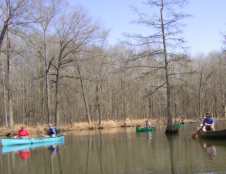SierraScape April-May 2005
Back to Table of Contents
by Jill C. Miller
In February, Sierra Club and six coalition partners from Missouri, Illinois and Indiana put a halt on construction of Peabody's proposed Prairie State coal plant by filing an appeal of Peabody's air pollution permit.

Canoeing at Mingo Swamp Photo courtesy of Jill Miller |
The permit, issued in mid-January by the Illinois EPA, would allow the 1,500 megawatt facility to emit more than 25,000 tons of soot and smog-forming emissions every year. Illinois EPA had granted the air pollution permit in spite of an outpouring of public comments opposed to the plant, as well as a finding from U.S. Fish and Wildlife Service that the Prairie State's emissions would have an "adverse impact" on Mingo National Wildlife Refuge in southeastern Missouri.
Our appeal was filed with the Environmental Appeals Board of U.S. EPA in Washington, D.C. and announced at a press conference at Frank Holten State Park near East St. Louis on February 23.
The plant would be sited in Washington County, IL, just 1.8 miles outside the non-attainment boundary for ozone and smog in metropolitan St. Louis, where asthma rates are twice the national average, according to the American Lung Association. The plant can't be built until the appeal is resolved.
John Thompson, Advocacy Coordinator for the Clean Air Task Force, called Peabody's permit "a mistake and a bad precedent" that takes away incentives for coal plants to use the cleanest technology available.
"Peabody's sulfur dioxide emission rate is five times higher than another proposed coal plant just two counties away," he said. "Better pollution controls exist, and Peabody's competitors are proposing to use them." Thompson gave a presentation about the Prairie State plant to the EMG Sierra Club conservation committee meeting in December 2004.
Organizations appealing the permit include the American Bottom Conservancy, American Lung Association of Metropolitan Chicago, Clean Air Task Force, Lake County Conservation Alliance, Sierra Club and Valley Watch of Indiana.
Grassroots Action:

Photo courtesy of Jill Miller |
In recent months, growing worries about air pollution from the power plant has spurred action from a wide spectrum of people in the bi-state region. Farmers, urban moms, wilderness lovers, and health and environmental justice advocates have been speaking out and getting noticed.
The weekend before Valentine's Day, more than two dozen people rallied in front of Peabody's downtown St. Louis headquarters, asked Peabody to "have a heart" and care about clean air in our community. Armed with colorful heart-shaped helium balloons and signs, the rally made the evening news and got the message across.
Jack Norman, chair of the Sierra Club's Kaskaskia group in Illinois, has been making a splash all over southern Illinois with his heart-shaped sandwich-board costume, informing citizens of the harmful effects of Peabody's pollution and making the local news. Residents who live near the plant are also fighting the zoning permit, and many have been sending letters to area newspapers to help get the word out.
A National Wildlife Refuge at Risk:
In mid-March, wanting to know more about the threat to Mingo National Wildlife Refuge in southeast Missouri near Puxico, a dozen Sierra Club members traveled there for a canoe trip outing. At the visitor's center atop Crowley's Ridge overlooking the 21,600 acres, refuge manager Virgial Harp gave us a presentation on the history, topography, and current and past management of the refuge, a swamp that was formed 18,000 years ago when an earthquake shifted the Mississippi River to the east.
Canoeing the Mingo River, a twisting, tea-colored waterway spiked with cypresses in the midst of bottomland hardwood forest, is the best way to get a feel for the area and see wildlife. On an unusually warm early spring day, we spotted sun-bathing turtles, a raccoon climbing a tree, a Pileated woodpecker, deer, a beaver, and yes, snakes-mainly non-venomous yellow-banded water snakes, but a couple of water moccasins, too.
U.S. Fish and Wildlife Service is required to assess potential effects from new pollution sources on "Class 1" designated wilderness areas like Mingo, and report the findings. Fish & Wildlife's finding of an "adverse impact" was only the second such finding in the past 20 years.
According to the data, sulfur dioxide and nitrogen oxides from Peabody's Prairie State coal-fired power plant, 85 miles away, would contribute to reduced visibility at the Refuge. The findings that Peabody submitted to IEPA, using the same modeling, were different, because IEPA let Peabody exclude any haze that occurred at night. Although EPA isn't required to address Fish and Wildlife concerns, it's extremely unusual not to, so Fish and Wildlife managers were taken aback when Illinois EPA issued Peabody's pollution permit without any further attempts to resolve the situation.
You can learn more about Mingo by visiting it in person, or going to www.fws.gov/midwest/mingo/.
Take Action!
Let's promote energy conservation and renewable energy in the Midwest, not dirty coal plants. The air we breathe and places like Mingo National Wildlife Refuge depend on it. So whether you can spend a little time or a lot, please get involved. Contact Jill Miller, Conservation Organizer at (314) 645-2032 or email jill.miller@sierraclub.org.
| The permit we are challenging would allow Peabody to emit up to: |
|---|
|